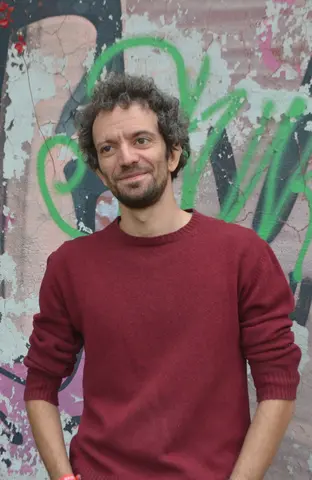Dr. Dr. Emiliano Urciuoli
emiliano.urciuoli@uni-erfurt.deJunior Fellow (Max-Weber-Kolleg für kultur- und sozialwissenschaftliche Studien)
Kontakt
Max-Weber-Kolleg (Steinplatz 2) / Raum 411 (3. OG)
Sprechzeiten
nach Vereinbarung
Besucheranschrift
Max-Weber-Kolleg für kultur- und sozialwissenschaftliche Studien
Campus
Nordhäuser Str. 63
99089 Erfurt
Postanschrift
Universität Erfurt
Max-Weber-Kolleg für kultur- und sozialwissenschaftliche Studien
Postfach 90 02 21
99105 Erfurt

Zur Person
Curriculum Vitae
Forschungsprojekt
Citifying Jesus Early Christians’ Making of an Urban Religion (1st-5th CE)
This project intends to readdress and reassess the time-honoured question of the relationship between early Christians and city-spaces: or, rather, between Christianness, as the specific religious quality of some Jesus followers’ practices of communication, and urbanity, as the peculiar socio-spatial form of city life. The research spans for almost five century, ranging from the first evidence of Jesus followers’ in Greco-Roman cities to the establishment of a state-sponsored and -controlled orthodox Christianity and the rise of extra-urban types of Christian practices (suburban, rural, and ‘desert’ asceticisms) and socio-spatial formations (monastic foundations).The geographical limits of the enquiry are those of the Roman empire in the period under consideration. The materials surveyed are both literary, inscriptional, and archaeological.
This research can be described as a socio-spatial analysis of the way Christian individuals and groups appropriated city-spaces’ density while engaged in the communication of Christian sign-systems and operating in urban-based social relations. An urban-based performance of religious communication is successful, insofar as it manages, at least for some time, to appropriate urban spaces in relation to a certain audience. Such a performance of religious communication in city-spaces is what I call ‘citification’. Instead of looking into a ready-made symbolic system preferably settled in cities but with an unknowable quantum of rural support, this project inquires in how far religious communication centred on the figure of Christ was not only taking place, but also taking shape in cities by adjusting to and appropriating the specific socio-spatial fabric of ancient city-space. The formation of early Christ-religion is thus described as the history of the space-dependent and space-forming citification of the religious practices and ideas related to Jesus.
The research seeks to analyze how and to what extent the citification of Jesus reflected the peculiar conditions under which Christian individuals avoided, selected, and negotiated communicative religious actions openly perceived and easily recognizable to other urbanites. It pins down and describes different trajectories – or sets of initiatives: a) cultural production of urban imagery; b) integration into the dense web of city-networks; c) dealing with urban concentration and dispersion by developing techniques of aloofness or intensifying ‘minor differences’; d) investment in literacy and literary culture; e) connection with the city margins and marginalities and impingement on the spatial bases of governmental power; f) short-term performances in situations of public visibility; g) professionalisation of religious functions; h) response to urban semiotic accumulation and human heterogeneity via either multiple religious affiliations or formation of normative religious identities; i) theologisation and liturgisation of urbanity and the construction of an ‘urbane’ religiosity.
The spatially informed approach engages with a larger set of questions impacting on the historical-religious understanding of the co-constitution of religion and urbanity in the Mediterranean antiquity: a) can urbanity as a way of life be extended to ancient Mediterranean religions too? Otherwise said: to what extent the ‘cityness of cities’ can be assumed not only as a locative predication, but as a constantly evolving formative element of past religions? b) given that urban agglomerations need practices that craft their spatially assorted areas, to what extent does religion successfully provide such services? c) what is the relationship between religious ‘citification’, as a multifarious urban accommodation and fashioning of religious communication, and societal ‘religionification’ as an epoch-making ‘shift of the social location of religion’ marked by the emergence of a new circum-Mediterranean ‘religious field’?

